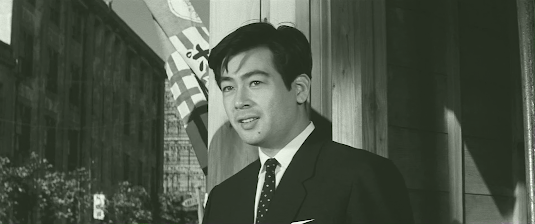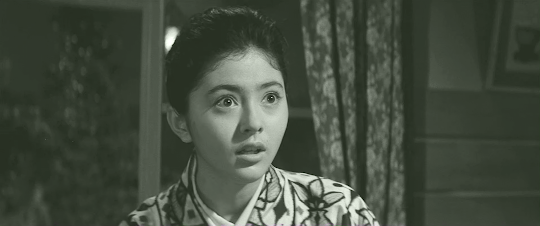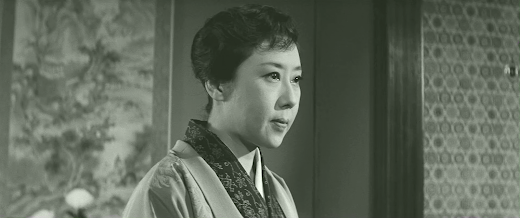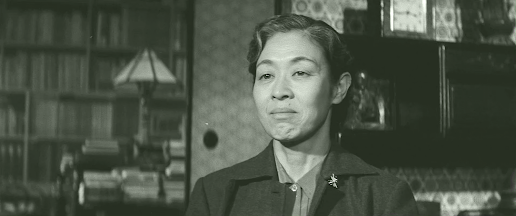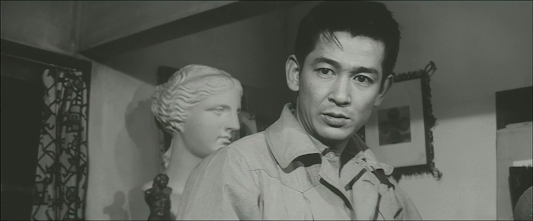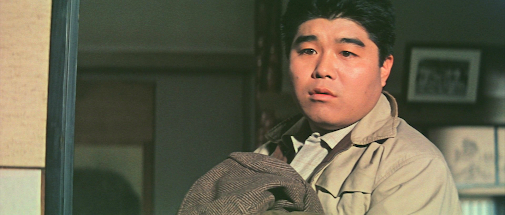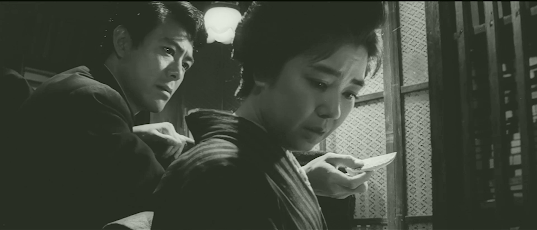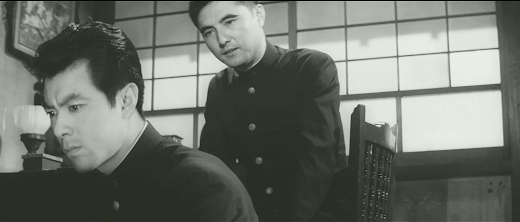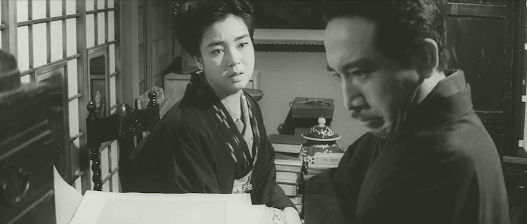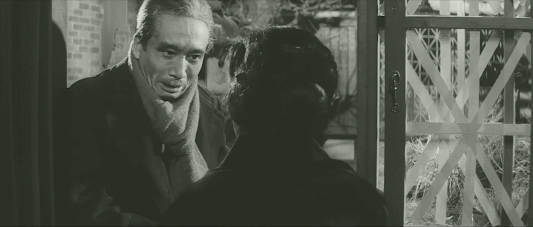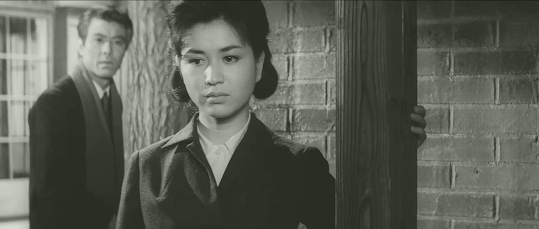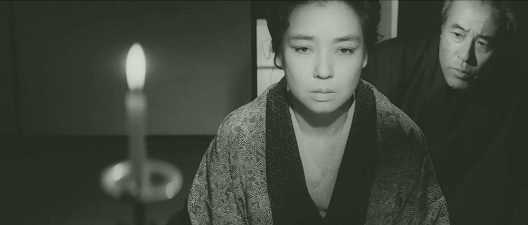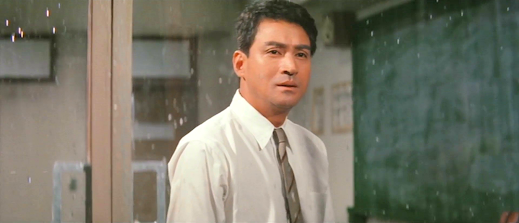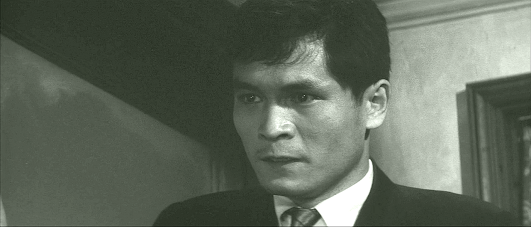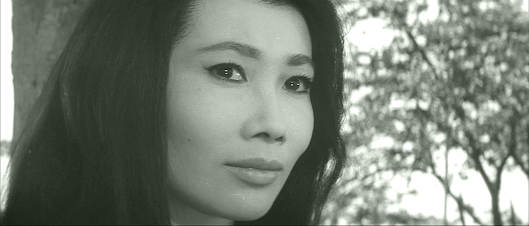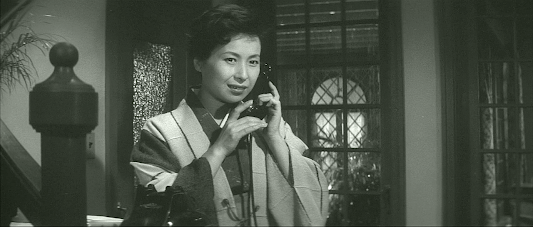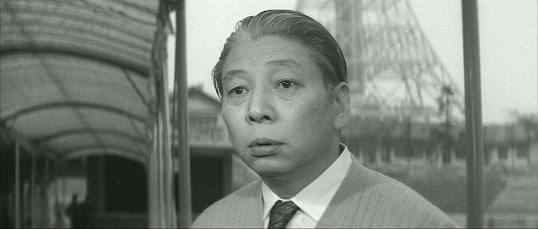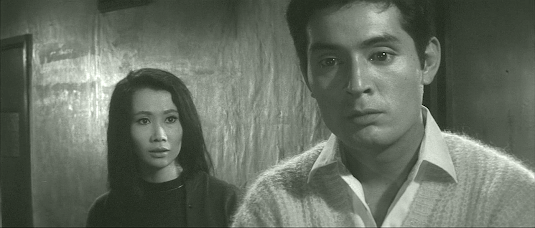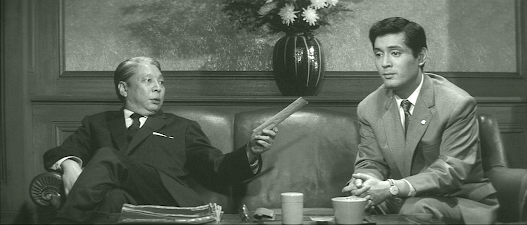M.R. Dowsing's Blog, page 8
November 15, 2024
The Makioka Sisters / 細雪 / Sasameyuki (‘Light Snowfall’, 1959)
Obscure Japanese Film #148
 Junko Kano and Fujiko Yamamoto
Junko Kano and Fujiko YamamotoJunichiro Tanizaki’snovel Sasameyuki is widely recognisedas a classic of Japanese literature. Translated into English as The Makioka Sisters in 1957 by Edward GSeidensticker, it has remained constantly in print ever since. The book wasoriginally published in serial form beginning in 1943, but this was soon haltedby the Japanese War Ministry – not because it criticised the government, butbecause, according to them at the time, ‘The novel goes on and on detailing thevery thing we are most supposed to be on our guard against during this periodof wartime emergency: the soft, effeminate, and grossly individualistic livesof women.’* I would have thought they should have been more worried about theenemy, but in any case, Tanizaki was forced to wait until the war had ended toresume publication, with the final instalment appearing in 1948.
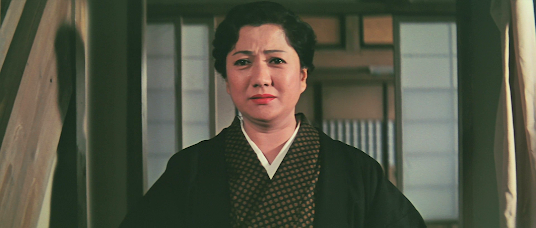 Yukiko Todoroki
Yukiko TodorokiThe story itself takesplace between 1936 and 1941, ending around eight months before the attack onPearl Harbour, and it seems that Tanizaki’s intention was partly to provide arecord of a way of life he had seen rapidly vanishing before his eyes. TheMakioka sisters are four adult siblings whose parents are no longer alive. Oncea grand family, their fortunes are on the wane but they remain very well-to-doin comparison with most Japanese and keep a number of servants. The eldest,Tsuruko (played here by Yukiko Todoroki), lives apart from the others with herhusband and children in what is referred to as the ‘main house.’ She is aperipheral character, but, as the senior surviving member of the family, theother sisters must defer to her and her husband before making any importantdecisions. Tsuruko later goes to live in Tokyo when her husband has to relocatefor his job, but her sisters remain in their hometown of Osaka.
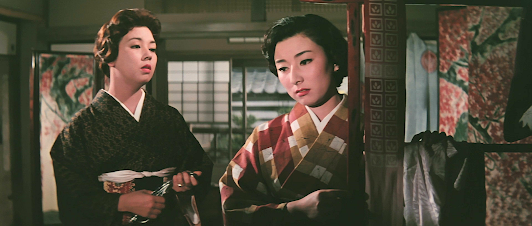 Machiko Kyo and Fujiko Yamamoto
Machiko Kyo and Fujiko YamamotoThe other three sisterslive together. In order of age, they are Sachiko (Machiko Kyo), Yukiko (FujikoYamamoto) and Taeko, familiarly called ‘Koi-san’ (Junko Kano). Sachiko ismarried to Teinosuke (Kyu Sazanka), with whom she has one child, Etsuko (TakakoShima). Although Sachiko is held responsible for her two younger sisters by themain house, little of the drama revolves around her. Instead, much of itconcerns the attempts to find a husband for Yukiko, whose shy and sometimesstubborn nature makes this difficult. Ever since her original fiancée waskilled in an accident, each marriage proposal has come to naught for one reasonor another, and Yukiko is already approaching 30 when the story begins.Complicating matters further is the fact that Taeko must wait until Yukiko ismarried before getting married herself in order not to humiliate Yukiko andleave her looking like an old maid that nobody wants. Taeko is the closestthing to a rebel in the family, generally doing as she likes and indulged byher older sisters, who make allowances for her due to the fact that theirparents died when she was so young. Even so, her disregard of the rules onlygoes so far and she avoids direct confrontation.
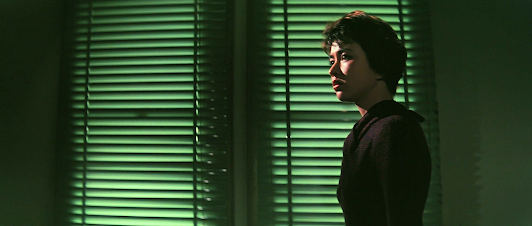 Junko Kano
Junko KanoThe sisters arelikeable characters who live their lives trapped in a web of etiquette.Overly-concerned with what others think, they are unable to make a move withoutfirst ensuring that what they do will not offend anyone else or damage theirown social status, but there’s little in the way of arrogance about them. Rather,they are simply behaving according to the rules by which they were brought upand it doesn’t even occur to them to do otherwise. In the book, Tanizaki paintsa minutely-detailed picture of their lives, but never tells us what to thinkabout it. The future of the family is left open at the end, but it’s impossibleto be unaware of the dark cloud of war that awaits them just over the horizon,and no doubt Tanizaki planned it that way.
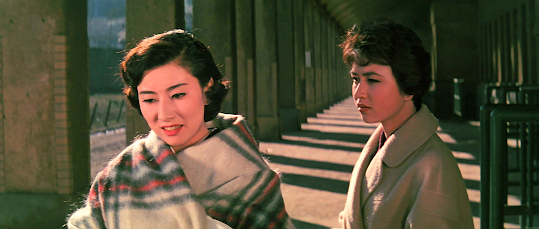
The first film versionappeared in 1950, directed by the forgotten Yutaka Abe, but notably starringHideko Takamine as Taeko. When Koji Shima came to direct this remake for Daiei, Tanizakiwas still alive (aged 74), and permission was sought from him to update thestory to the present day, which he granted. I doubt whether this was to savemoney as the Japanese film industry seemed to have plenty to throw around in1959, so I suspect the idea was to broaden the appeal to the modern audience. Thestory transfers with surprising ease to the Japan of the late ‘50s, but ofcourse the feeling of watching a vanishing way of life is mostly lost.
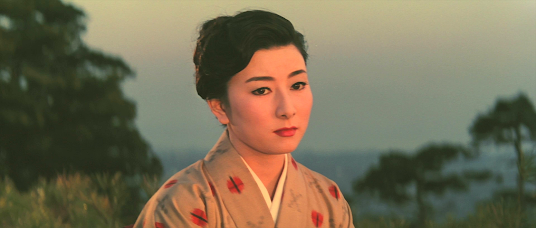
The wisdom ofattempting to condense a novel which comes in at 530 pages (in its Englishtranslation) into a film running an hour and 45 minutes is also open toquestion. This episodic kind of material is probably better-suited totelevision and, in fact, there have been six different versions made forJapanese TV over the years. These misgivings aside, screenwriter Toshio Yasumidoes a creditable job under the circumstances, choosing to concentrate less onthe attempts to arrange a marriage for Yukiko and instead focus on the eventsrevolving around Taeko, which are somewhat more dramatic.
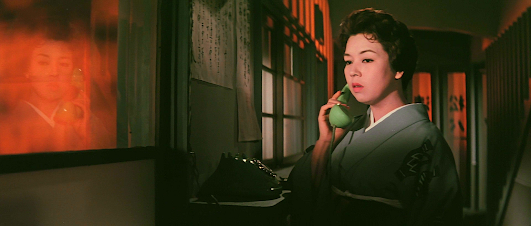
One of the best thingsabout this film is the casting – all of the main actors are well-suited totheir roles and are talented enough to make them feel like real people. It alsolooks a treat, with some interesting lighting choices including director KojiShima’s trademark orange glow of sunset in several scenes, while the music – atleast once the main credits are over – is restrained and tasteful.Cinematographer Joji Ohara and composer Seitaro Omori were both regularcollaborators of the director. Shima had a fondness for storms as well assunsets, which is just as well as the book contains a dramatic storm sequencewhich he pulls off nicely here. He also shows great skill at co-ordinating his actors,who perform all sorts of little bits of business during their dialogue sceneswith great naturalism. Along with films such as The Beloved Image and ARainbow at Every Turn, The MakiokaSisters provides further proof that Koji Shima was not simply a hackwho made Warning from Space and The Phantom Horse, but was also a trueartist when he wanted to be.
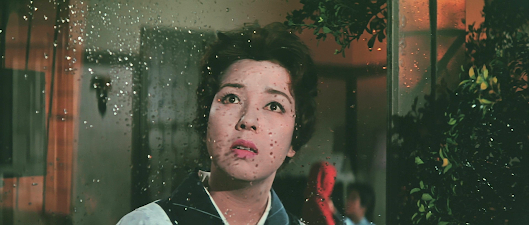
Bonus trivia: After 20years of being blacklisted, Fujiko Yamamoto (who plays Yukiko here) was invitedback to the big screen by Kon Ichikawa to play Tsuruko in his 1983 remake. After thinking aboutit for six months, she said no and decided to stick with her stage work.
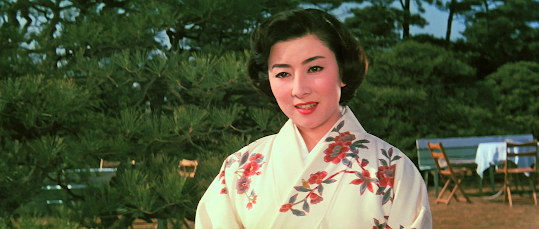
*Rubin,Jay. Injurious to Public Morals: Writers and the Meiji State. Seattle:University of Washington Press, 1984. P.264.
Blu-ray at Amazon Japan (no English subtitles). This comes with a bonus DVD of a rare early Machiko Kyo film apparently, but I haven't been able to determine the title.
DVD at Amazon Japan (no English subtitles).
Thanks to A.K.
November 10, 2024
The Pit of Death / 怪談おとし穴 / Kaidan otoshiana (aka ‘The Ghostly Trap’, 1968)
Obscure Japanese Film #147
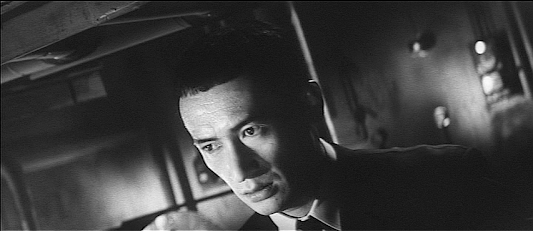 Mikio Narita
Mikio NaritaKuramoto (Mikio Narita)is an ambitious salaryman working at a company based in a tower block said tobe haunted by the ghost of a typist who went missing. He’s in a relationshipwith her replacement, Etsuko (Mayumi Nagisa), who wants to marry him, but he's also being pursued by the boss' daughter, Midori (Mako Sanjo), andhe wants to ditch Etsuko and marry Midori so he can get an easy promotion. Etsuko won’t lethim go so easily, however, so he begins scheming about ways to get rid ofher…
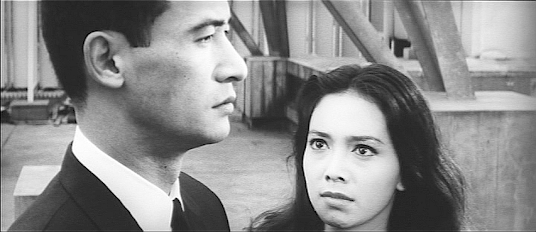 Narita and Mayumi Nagisa
Narita and Mayumi NagisaAs played by MikioNarita with a Spock-like haircut, Kuramoto seems an unlikely babe magnet. Japanese Wikipedia observesthat this was his only leading role in a film, and it’s not hard to see why –most of the time here, he’s so wooden that he resembles a stick with a humanface (though, having said that, it’s only fair to point out that he had a reputationfor being excellent at playing nihilistic villains, mainly in yakuza films). Naritais also not helped by having to play opposite an actor as expressive as MayumiNagisa.
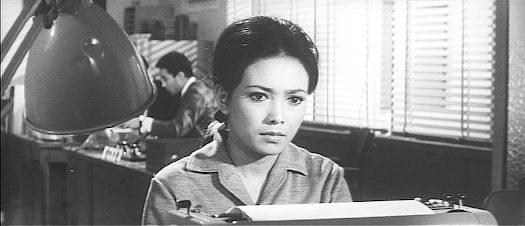
The film was apparentlyreleased on a double bill with Satsuo Yamamoto’s Peony Lantern, so it’s aB-movie, but even so it looks as if the penny-pinching at the struggling Daieistudios was really starting to bite. The exterior scenes are mostly shot intoo-bright sunlight, and many of the interior ones are lit by equallyoverpowering sunshine pouring in through a nearby window or by lamps which arepart of the set. It’s almost as if director Koji Shima was told that theycouldn’t afford those big, expensive movie lights anymore, so he’d have to makedo without.
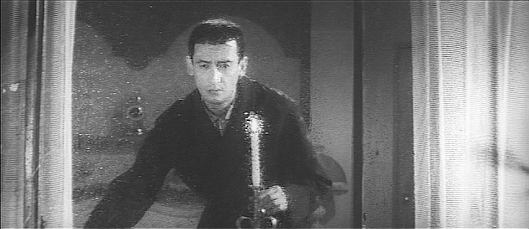 Narita looks out at one of Koji Shima's trademark storms
Narita looks out at one of Koji Shima's trademark stormsAlthough the script isan original work by Kazuo Funahashi – who had an impressive track record – the thinstory feels stretched out even at 78 minutes. An example of this is when a confrontationscene between Kuramoto and Etsuko on the rooftop is virtually repeated againimmediately after in the stationery cupboard. However, despite its obviousflaws, The Pit of Death manages some atmospheric and creepy scenes togetherwith a couple of clever surprises. The highlight is probably the murder scenewhich takes place in the basement of the office building and is accompanied bya cacophonous score evoking the sound of clanking pipes. Speaking for myself, I had low expectations for this film, but was pleasantly surprised on the whole. The film's unusual office block setting, excellent jazz soundtrack (by Shima's regular collaborator Seitaro Omori) and black-and-white VistaVision cinematography together give it a unique feel for a film of this vintage.
Director Koji Shimaended his career at Daiei with this film, then went to Hong Kong the following year and made a longer version of the story forthe Shaw Brothers (entitled Luo shi hen, aka Dear Murderer).

English subtitles courtesy of Coralsundy can be found here.
DVD at Amazon Japan.
November 9, 2024
Shojo yutai / 処女受胎 (‘Immaculate Conception’, 1966)
Obscure Japanese Film #146
 Ayako Wakao
Ayako WakaoThis Daiei productionstars Ayako Wakao as Aiko, a modernist oil painter who has hit a creative wall.Searching for inspiration, she comes to believe that having a child will solveher problems but, having no desire to get married, she decides to tryartificial insemination. One of the sperm donors at the clinic she attends is astudent, Satoru (Takao Ito), who likes to feel that his sperm is going to beautifulwomen. When he sees Aiko visiting the clinic and learns she is a patient, hepressures a nurse, Keiko (Sanae Nakahara), to ensure that it’s his seed thatAiko receives…
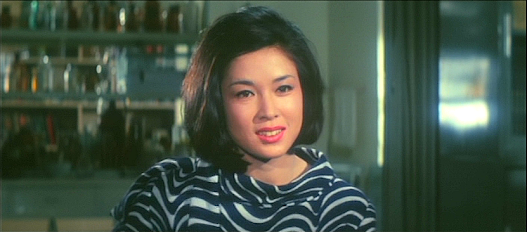
Based on a novel by JugoKuroiwa, (who had also supplied the source material for With My Husband’s Consent), this is a silly story in questionabletaste and with a very poor ending. The film relies heavily on its star, who Ibelieve has even more costume changes here than she did in Ojo-san – although in this case some of the clothes look like theycould have come from Primark. In fact, the whole thing looks like it was shoton the cheap and in a rush, which may partly be due to shrinking budgets atDaiei at the time. However, the film’s short running time of 82 minutes andtotal lack of name actors other than Wakao also suggests that it was mostlikely a B-movie which played at the bottom half of a double bill.
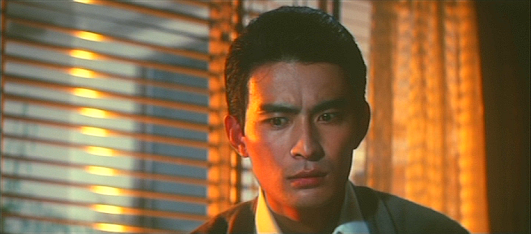 Takao Ito basks in Shima's trademark sunset lighting
Takao Ito basks in Shima's trademark sunset lightingDirector Koji Shima hada weakness for the orange glow of sunset in his colour films, and this is featuredin a number of scenes here. He also liked to make dramatic use of harsher kindsof weather, so it’s no surprise to see a rainstorm at one point. Another Shimatrademark is his use of symbolic shots, which are mostly absent from this film,apart from this rather clumsy one which again indicates that haste was the nameof the game in making this movie:
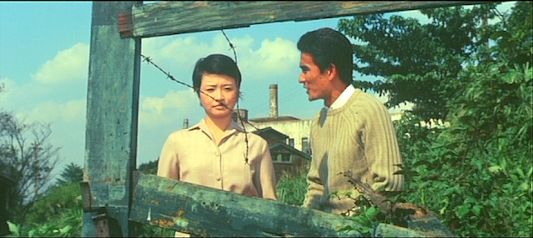 Sanae Nakahara and Takao Ito
Sanae Nakahara and Takao ItoI love a good dream sequence, but the onefeatured here is pretty mediocre and rather obviously shot through a layer of gauze(as are, for some reason, the scenes at the beginning of the film in which Aikosearches for inspiration in a windy field, at a flamenco dance and at a divingpool).
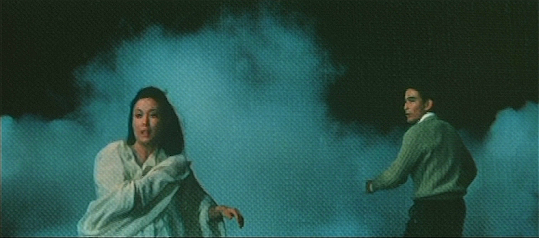
All in all, Shojo yutai is a very shallow treatment of thetheme of artificial insemination which tries to redeem itself with some awkwardmoralising towards the end before getting really weird in the final scene, whentalk of Aiko viewing men as mere ‘fertiliser’ causes one character to act in a most peculiar fashion.
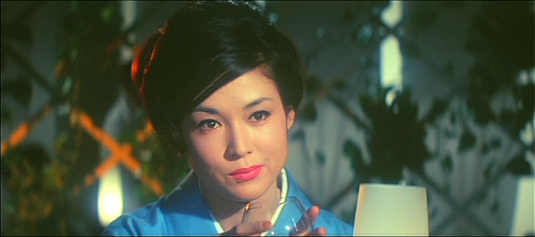
Thanks to A.K., and to Coralsundy for the English subtitles, which can be found here.
November 6, 2024
Love in the Mountains / わかれ / Wakare (‘Parting’, 1959)
Obscure Japanese Film #145
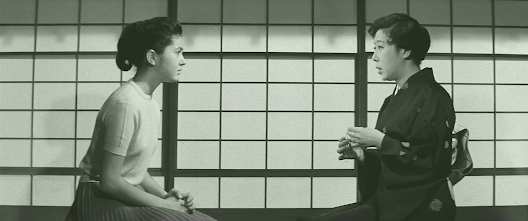 Haruko Wanibuchi and Isuzu Yamada
Haruko Wanibuchi and Isuzu Yamada
Teenager Kimiko (Haruko Wanibuchi) helps out at a ryokan (traditional inn) in Hakone owned by her widowed mother, Kuniko(Isuzo Yamada). One of the regular guests is a writer named Shimizu (ChishuRyu), who likes to stay there and use the nearby golf course. On one visit hebrings a student assistant, Keiichi (Eiichi Sugasawara), with him, and Keiichiand Kimiko fall in love. However, the course of true love never runs smooth,and matters are complicated by a proposal from a rival suitor as well as by ayoung man who works at the inn, Taiji (Shoji Yasui), who secretly loves Kimiko,and then there’s Keiichi’s domineering mother (Sachiko Murase), who has otherplans for her only son…
Although it throws in a couple of sub-plots involving a couple ofKuniko’s employees who have an illicit relationship resulting in a pregnancy anda former employee who now works in a restaurant to pay for her brother’smedical care, this Shochiku production feels a little thin in the storydepartment even though it was based on a 1955 novel entitled Hana mizukara oshie ari (‘Flowers Teach Themselves’)by Jun Takami (1907-65).
It’s a sentimental film, and I found HarukoWanibuchi’s wide-eyed naivety a tad cloying (Iassume her character was supposed to be a little older), but it’s also well-shot and has anicely varied music score by Mitsuo Kato. Chishu Ryu’s character is not muchmore than a plot device to bring Kimiko and Keiichi together, but he doesmanage to invest it with some personality. The dramatic highlight of the film,however, is the face-off between Isuzu Yamada and Sachiko Murase, two fine veteranactresses best-known for their work with Kurosawa – Yamada was, of course, theLady Macbeth equivalent in Throne ofBlood, while Murase was the elderly A-bomb survivor in Rhapsody in August.
Of the director, Masao Nozaki, I’ve been ableto find out almost nothing, other than the fact that he directed seven filmsbetween 1952 and 1960, all for Shochiku. On the basis of this well-made film, Ivery much doubt that the abrupt end to his career could have been due toincompetence, so perhaps he passed away around 1960 or slept with the studiohead’s wife.
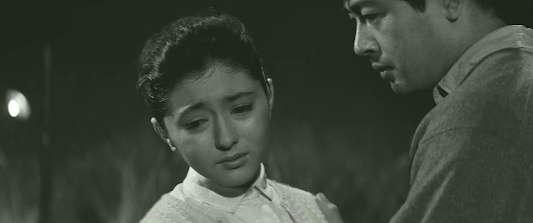 Haruko Wanibuchi and Eiichi Sugasawara
Haruko Wanibuchi and Eiichi Sugasawara
November 3, 2024
The Tycoon / 傷だらけの山河 / Kizudarake no sanga (1964)
Obscure Japanese Film #144
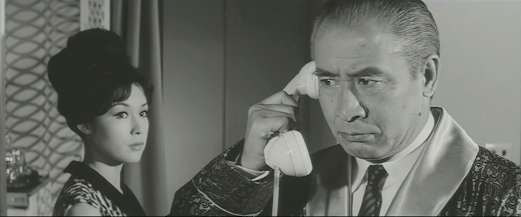 Ayako Wakao and So Yamamura
Ayako Wakao and So Yamamura
Having delivered amega-hit for Daiei studios with Shinobino mono (1962) and also directed its first sequel the following year,director and lifelong Communist Party member Satsuo Yamamoto was in a strongposition to make what he wanted, and so chose the latest novel by TatsuzoIshikawa, a writer who shared his political sympathies and had previously providedthe source material for Yamamoto’s TheHuman Wall (1959).
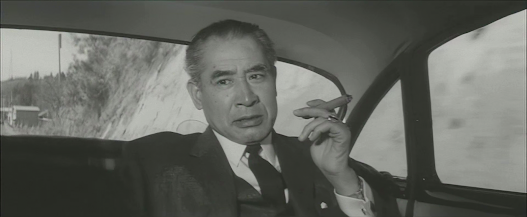
Adapted by one-man scriptwritingmachine Kaneto Shindo, The Tycoonstars So Yamamura as the titular character, Kappei Arima, a business magnatewith his fingers in numerous pies who has plans to build a new railway line andbuy up as much land as possible around the proposed locations of the railstations. Protests by residents are dealt with through bribery or intimidation.Although married, Arima also has two mistresses, and his wife and bothmistresses each have a grown-up son. However, he feels that these women are allpast their prime so, when he notices an attractive young woman, Mitsuko (AyakoWakao), working in his office as a poorly-paid bean counter, he hatches a planto make her his new mistress.
Mitsuko is living with Sakai (KeizoKawasaki), a struggling artist who believes that he could be successful if hecould only study in Paris. She is largely supporting him on her meagre salary,and is thoroughly fed up with living in poverty. One day, she finds herselfunexpectedly summoned to Arima’s office and receives a shocking proposal: Arimaoffers to pay to send Sakai off to France for three years and provide Mitsukowith an apartment and an ample allowance if she will be his mistress whileSakai’s away. Understandably shocked, she initially refuses, but, after talkingit over with Sakai, thoughts of the money encourage them to take a morepragmatic view, and they decide to accept the offer. Meanwhile, Arima’sillegitimate sons have both become dissatisfied with their status and decide intheir different ways to do something about it…
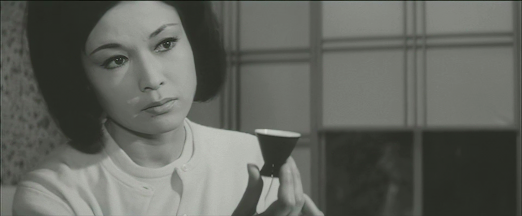 Mitsuko makes her Faustian pact
Mitsuko makes her Faustian pact
Arima’s avarice andselfishness leave a trail of broken lives in his wake, which explains why theJapanese title translates as something like ‘Mountains and Rivers of Wounds’.The character was loosely based on the real-life Yasujiro Tsutsumi, who passedaway at the age of 75 just three weeks after this film was released. Oddly, operasinger Yoshie Fujiwara (1898-1976) was originally cast as Arima at thesuggestion of producer Masaichi Nagata. According to Satsuo Yamamoto in his autobiography,it quickly became apparent that Fujiwara could not act, so he was replaced by SoYamamura – who had actually been Yamamoto’s first choice but was unavailable,then luckily became available again. Yamamura proved to be the perfect choiceand won a Kinema Junpo Best Actor Award for his performance. The strength ofhis portrait is the way in which it shows Arima not as a mere bully, but as acharismatic man of some humour and charm who knows how to persuade people tocome round to his way of thinking, as he does very effectively with Mitsuko.
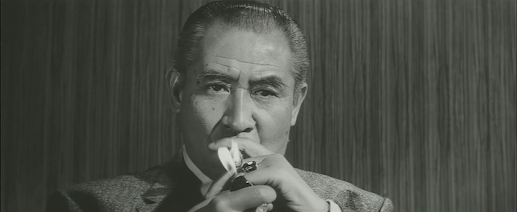
Like many Yamamotofilms, The Tycoon is rather long (152minutes), and in this case it feels it. There’s no real development of the mainprotagonist – Arima is a greedy capitalist bastard at the beginning of thefilm, and he’s still a greedy capitalist bastard at the end – and it all gets abit repetitive as he lights another big cigar and steamrollers the oppositionin yet another board meeting. The sons do not make for very compellingcharacters, and Mitsuko’s chance meeting with Arima’s only legitimate son,Akihiko (Koji Takahashi), which leads to an affair, just seems like a clumsilycontrived excuse to pile on the melodrama. That’s not the silliest part, though– that prize must be reserved for the scene in which Sakai explains to Mitsukothat he has been visited by a private detective wanting to investigate the twoof them without saying why and Sakai has told him everything he wanted to knowinstead of telling him to sod off as any sane person would do.
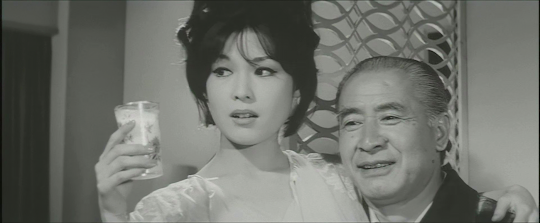
Yamamoto was a good(but in my opinion not great) director, and this is a well-made film, butsometimes his ideological stance veers too close to communist propaganda, and Ifeel that The Tycoon is a case inpoint. It’s certainly true that people like Arima exist, but it’s not clearwhat the film has to tell us other than that greed is bad, so thetwo-and-a-half-hour running time feels unwarranted. Wakao manages to give herpart more depth than most would have managed, and we can see how conflicted Mitsukois, but still, it’s a supporting role and the focus is not on her for the mostpart. However, despite its flaws, the film was well-received at the time andranked 7th on Kinema Junpo’s best films of the year list.
 Yatsuko Tan'ami as one of Arima's mistresses, with a Noh mask of Ko-omote perhaps representing her long-lost innocence
Yatsuko Tan'ami as one of Arima's mistresses, with a Noh mask of Ko-omote perhaps representing her long-lost innocence
Thanks to A.K., and toCoral Sundy for the English subtitles which can be found here.
DVD at Amazon Japan.October 31, 2024
Hot Spring Doctress / 温泉女医 / Onsen joi (1964)
Obscure Japanese Film #143
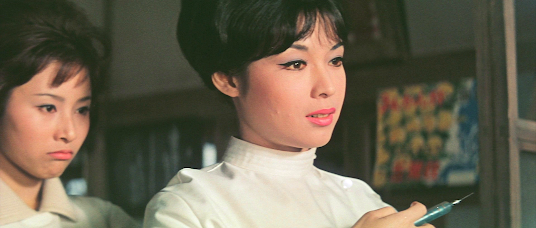
When a new doctorarrives to replace the old drunk Dr Yabuuchi (Ichiro Sugai) at a hot springresort in Izu, the residents are shocked to learn that his replacement is(gasp!) a woman, Dr Shiotsuki (Ayako Wakao). She proves to be strong-willed andsoon gains the respect of the often badly-behaved residents, who include DrYabuuchi’s best friend, randy old codger Tahei (Ganjiro Nakamura playing totype); Yabuuchi’s rotund son, Masahiko (Taro Marui), who looks after the localorphans; and cynical geisha Omura (Utako Shibasawa), who Dr Shiotsuki tries totalk out of having an abortion…
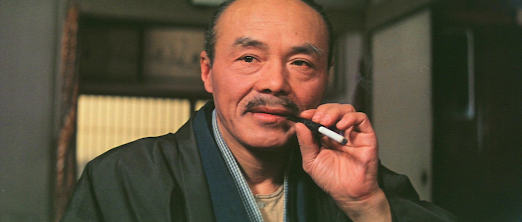
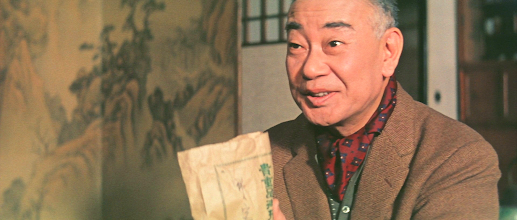
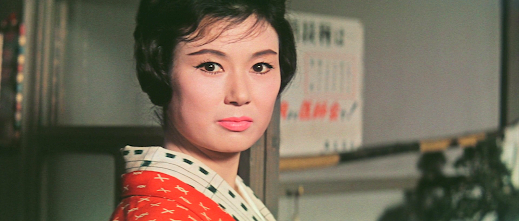
This Daiei production wasthe final entry in their series of five ‘onsen’ B-pictures which began with Onsengeisha in 1963 (not to be confused with Toei’s later ‘Onsen Geisha’ serieswhich ran from 1968-75). It’s one of nine films that Wakao made with directorKeigo Kimura (1903-86), a veteran who made his first film in 1930 and retiredtwo films after this one, having directed 93 pictures. His filmography covers awide range of genres, including a number of prestigious literary adaptations,and his 1955 film Sen-hime was nominated for the Palme d’Or. Like many of hismovies, that one starred Machiko Kyo, whom he had been responsible for bringingto prominence with his 1949 film, A Fool’s Love. Hot Spring Doctress seems torepresent something of a comedown for Kimura, whose work is hard to judgeoverall as so little of it is currently accessible.
On the whole, this is arather dated but harmless comedy which is not as sexist as it might have beenand passes the time pleasantly enough, getting by largely on the considerablecharm of its star, Ayako Wakao. It’s also hard to dislike a film in which theromantic male lead is the portly Taro Marui, a Daiei contract actor who hadscored a hit in Zuzushii yatsu (‘Shameless Guy’), a TV drama produced by Daieiin 1963. Marui subsequently received many offers from other TV productioncompanies, but Daiei refused to loan him out. His career sufferedwhen he spoke out about this, and he committed suicide in 1967.
Thanks to A.K., and toCoral Sundy for the English subtitles, which can be found here.
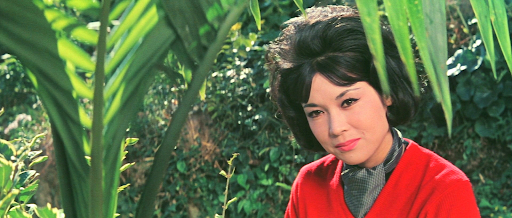
October 29, 2024
A Woman’s Life / 女の一生 / Onna no issho (1962)
Obscure Japanese Film #142
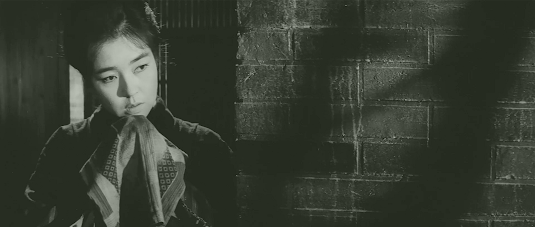 Machiko Kyo
Machiko Kyo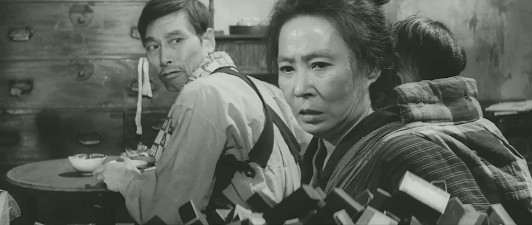 Jun Hamamura and Fumiko Murata
Jun Hamamura and Fumiko Murata
1905. Kei (Machiko Kyo) is a young woman orphaned by the Russo-Japanesewar who now lives with her alcoholic uncle (Jun Hamamura) and his shrewish wife,Okura (Fumiko Murata). They treat her like a slave and Okura beats her with astick at the slightest excuse. One night, Kei finds herself thrown out of thehouse and told not to return.
Wandering the streets, she is attracted by thesound of singing and enters a garden, which leads to an encounter with young soldierEiji (Jiro Tamiya), who is about to resume his studies after completing hismilitary service. Hearing of her troubles, he is moved and invites her in tomeet his family, who end up adopting her.
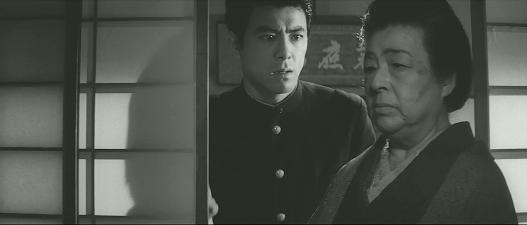 Jiro Tamiya and Chieko Higashiyama
Jiro Tamiya and Chieko Higashiyama
The family are headed by widow and matriarch Shizu (ChiekoHigashiyama), who – since her husband's death – has been running the family trading company with some help from Eiji’s uncle (Eitaro Ozawa), a crippled warveteran. The family also includes Shizu’s other son, the artistically-inclinedShintaro (Masaya Takahashi), as well as two grown-up daughters, Fusako (YokoUraji) and Fumi (Yoko Miki).
Eiji has become close friends with a fellow student, Song (TakashiNakamura), who is from China, and this has made him very sympathetic to theChinese. However, the family’s trading company imports goods from China andscant attention is paid to the ethics of how these goods are acquired.
Meanwhile, Kei is so grateful for having been saved fromhomelessness and probable prostitution that she does everything she can toplease the family who have taken her in, working tirelessly and nevercomplaining. After five years of this, Shizu has become so impressed by Keithat she wants her to marry Shintaro and take over the family business. Keiloves Eiji, but her sense of obligation will not allow her to go againstShizu’s wishes, so she agrees. She proves adept at handling the tradingbusiness, but unfortunately develops a kind of moral tunnel vision which leadsher to prioritise the success of the company over all human relationships…
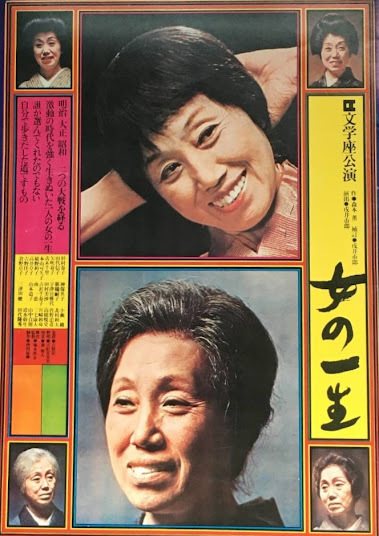 Cover of programme for 1973 stage performance starring Haruko Sugimura
Cover of programme for 1973 stage performance starring Haruko Sugimura
Despite the title, A Woman’sLife is unrelated to the famous Guy de Maupassant novel and is in factbased on the final play written by Kaoru Morimoto,* which premiered in April1945 at the Toyoko Cinema in Shibuya during a gap between air raids. Morimoto’slover, actress Haruko Sugimura, originated the role of Kei, which was said tohave been written for her, and she went on to perform it 947 times. Morimotoand Sugimura were both affiliated with the Bungakuza theatre company, whoproduced the play. A shingeki company(meaning they performed translations of Western works as well as new Japanesedramas influenced by the West), Bungakuza was a friendly rival to Haiyuza and hascounted among its members such luminaries as Kyoko ‘Woman of the Dunes’Kishida, Kirin Kiki, and even – for a while – Yukio Mishima. Morimoto revisedthe play after the war ended, making it more critical of the Japanesegovernment and military, but he passed away shortly after as a result oftuberculosis, aged just 34.
Covering a period of 40 years and ending shortly after the SecondWorld War, the story involves most of the major characters growing old.Fortunately, this ageing is very well done both in terms of performances andmake-up, with Masaya Takahashi especially convincing as an old man. Major newcharacters are also introduced late in the story, such as Kei’s daughter,played by Junko Kano. It’s hard to think of a director other than YasuzoMasumura who would have crammed so much into a mere 94 minutes. The script isthe work of prolific screenwriter Toshio Yasumi, who specialised in adaptationsof literary works, and it’s clear that Masumura put a lot of care and attentioninto this one, making it one of his best (if not most characteristic) films.The cinematography by Yoshihisa Nakagawa is first-rate and Sei Ikeno’s score is alsoeffective, though perhaps a little too ominous. As for the cast, all are fineactors at the top of their game and it’s astonishing that not even Machiko Kyowas nominated for an award.
All in all, A Woman’s Lifefeels like a real classic of Japanese cinema, so why it’s not better known isbeyond me. As there is a credit at the beginning stating that “This film participatedin the 1962 Festival of Arts”, Daiei studios must have felt at the time thatthey had produced something of real artistic merit, and in this case they were undoubtedly right.
*There are at least six other Japanese films entitled Onna no issho, none of which are basedon Morimoto’s play.October 23, 2024
While Yet a Wife / 妻の日の愛のかたみに / Tsuma no hi no ai no katamini (1965)
Obscure Japanese Film #141
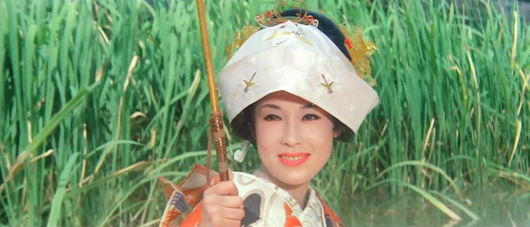 Ayako Wakao
Ayako WakaoChieko (Ayako Wakao)and Kitahara (Eiji Funakoshi) are country schoolteachers who get married andappear to be the perfect couple. Liked but a little envied by the locals forhaving such a happy relationship, the two are looking forward to having achild. Then one day Chieko begins to suffer from mysterious pains which won’tgo away. A doctor diagnoses arthritis, and the young couple find their liveschanged forever…
This Daiei production wasbased on a memoir by Mieko Ikegami and adapted by Keisuke Kinoshita, butdirected by Daiei contract director Sokichi Tomimoto, who made six films withAyako Wakao. It has something of the feel of a Kinoshita film – albeit a minorone – due to the rural setting and score by Kinoshita’s brother and regularcollaborator, Chuji Kinoshita. Unfortunately, this is one of those times whenthe composer does not seem to realise that silence would sometimes bepreferable, and the film suffers from an overuse of maudlin harp and stringsthroughout.
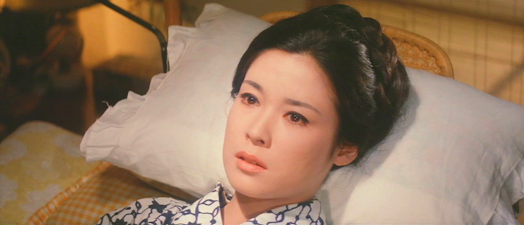
The story’s pretty thinfor a 90-minute picture, hence the brevity of my synopsis, and it’s notconvincing as a portrait of someone suffering from severe arthritis, probablybecause the studio didn’t want to risk making Wakao look unattractive. It’snice to see the underrated Eiji Funakoshi in a serious leading role for achange, and he does as good a job as anyone could be expected to under thecircumstances, as does his more celebrated co-star. Although he was often castin comic roles, the highlight of Funakoshi’s career was undoubtedly in KonIchikawa’s Fires on the Plain (1959),an atypical part for him, but a good example of successful casting againsttype.
All in all, this is a decent enough tearjerker, but nothing more.
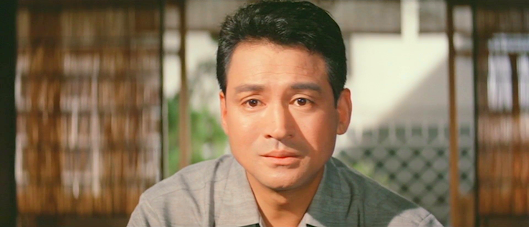
Note on the title: TheJapanese title translates as something like ‘In the Spirit of Love on My Wife’sDay’
Thanks to A.K.
DVD at Amazon Japan (no English subtitles).
October 19, 2024
The Blue Beast / 青い野獣 / Aoi yaju (1960)
Obscure Japanese Film #140
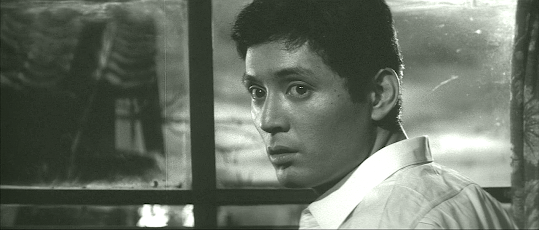 Tatsuya Nakadai
Tatsuya NakadaiYasuhiko Kuroki(Tatsuya Nakadai) is an ambitious young man working for a magazine publishingcompany run by Ogawa (Jun Tazaki). When a pay dispute breaks out, the unioncalls a strike and Kuroki serves as a spokesman for the workers. However, he’sactually a mole working for the management, who are paying him in exchange forinside information.
Going for a drink withfellow union member Goda (Ichiro Nakatani), Kuroki is surprised to find his oldflame from his student days, Yoshie (Keiko Awaji), working at the bar. It’s thefirst time they’ve seen each other for 6 years and their former passion is soonrekindled, but Kuroki is unaware that Goda has become suspicious and askedYoshie to keep an eye on him.
Meanwhile, Kuroki hasbeen having an affair with Ogawa’s wife, Yoriko (Yatsuko Tan’ami), whom he washired to tutor part-time while still a student. She had used her influence on herhusband to get Kuroki his job, but now she’s just in his way, so he breaks itoff by telling her in brutal fashion that she’s too old to be attractive anylonger.
Kuroki next sets hissights on Fumiko (Yoko Tsukasa), the daughter of powerful financier Eto (playedby Nakadai’s real-life mentor, Koreya Senda). He knows that if he can getFumiko to marry him, he’ll be made for life…
Yasuhiko Kuroki is anamoral social climber in the tradition of Stendhal’s Julien Sorel in his 1830novel The Red and the Black,Dreiser’s Clyde Griffiths in An AmericanTragedy (upon which the 1951 film APlace in the Sun starring Montgomery Clift was based), and especially JohnBraine’s Joe Lampton in Room at the Top,filmed in 1958 with Laurence Harvey as Joe. That film was released in Japan inJuly of 1959, and very likely inspired this one as the similarities areobvious, although the two films end quite differently.
TheBlue Beast, a Toho production, was written by Yoshio Shirasaka,who wrote a number of films for Yasuzo Masumura, but – more significantly – hadalso written the screenplay for The Beast Must Die (1959), in whichNakadai had starred as a similar (though more deadly) antihero. Although theending of that film seemed to leave things wide open for a sequel, it alsocalled for location shooting in a foreign country, which is probably why itnever happened. I’m unsure of the significance of the colour blue, but it seemshighly likely that the inclusion of the word ‘beast’ in the title here wasintended to tell audiences that this was their opportunity to see Nakadai being... well, 'beastly' again (especially to women).
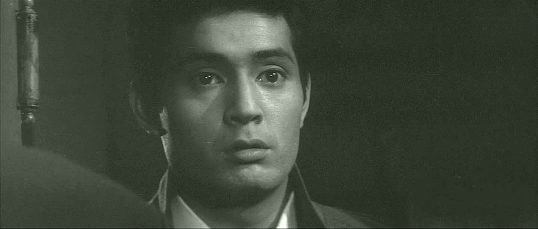
For Nakadai, this wasthe first of four collaborations with director Hiromichi Horikawa, but it’s notas good as the other one I’ve seen, Shiroto kuro (1963), and it’s also less interesting than The Beast Must Die. It feels rather oddly lacking dramatically,partly because it unfolds all too predictably, but also because – unlike JulienSorel, Clyde Griffiths and Joe Lampton – Yasuhiko Kuroki lacks anythingresembling a sympathetic side. He’s a pretty one-dimensional character, really,and that’s also probably why Nakadai’s not at the top of his game here. SeiIkeno’s soundtrack, which prominently features the vibraphone and recalls theModern Jazz Quartet, may also have been too mellow a choice for this type ofdrama.
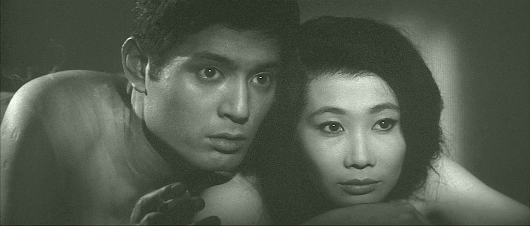
Thanks to A.K.
October 15, 2024
Women and Miso Soup / 女と味噌汁 / Onna to misoshiru (1968)
Obscure Japanese Film #139
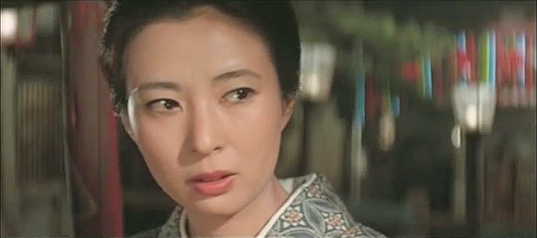 Junko Ikeuchi
Junko IkeuchiChikako (Junko Ikeuchi)is a geisha who works under the name of Temari. Such an occupation gives her avery low social status, but she has managed to retain her self-respect,restricting herself to entertaining her customers and not sleeping with them assome do. However, though she never allows herself to indulge in self-pity, Chikakois not entirely satisfied with her lot and wants to become less dependent onthe whims of men. As she always receives compliments for the miso soup shemakes based on her grandmother’s recipe, she decides to start a small businessselling the soup and accompaniments from a mobile van.
Attending a classreunion, she reconnects with some old school friends: Murata (Kei Sato), aself-confident and apparently successful businessman; Ogawa (Kunei Tanaka), whomakes a modest living carrying on his father’s occupation of making geta (traditional wooden sandals); andKazuyo (Etsuko Ichihara), who has four children and another on the way and isforced to supplement her husband’s income by trying to sell life insurance oncommission.
Murata and Ogawa bothseem keen to be more than just friends with Chikako, but she’s more interestedin Kiritani (Keizo Kawasaki), a salaryman she meets while working. However,this is a world in which even the nice guys shouldn’t be entirely trusted…
Another incident whichcomplicates Chikako’s life is the unexpected arrival of a half-brother shedidn’t know she had, Tomoichiro (Masakazu Tamura), who is studying to be adoctor. Chikako’s young friend and colleague Komomo (Aiko Nagayama) falls inlove with him, but when Tomoichiro and Komomo begin talking of marriage,Chikako finds herself reacting with resentment at the idea of her brothermarrying a lowly geisha. Having suffered from spending her own life in a societywhere the most important thing is what other people think of you, her kneejerkreaction is hypocritical, but – to her credit –she comes to realise this.
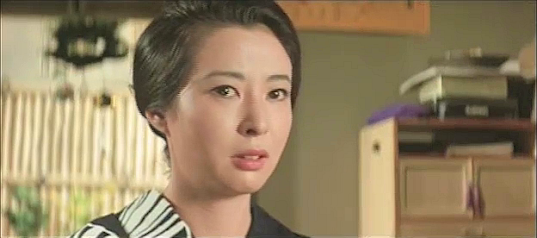
This Tokyo Eiga productionwas based on a 1965 novel by Yumie Hiraiwa which had already been successfullyadapted for TV in a version which also starred Junko Ikeuchi and Aiko Nagayamain the same roles. Although Women andMiso Soup is the sort of character-driven comedy-drama that had largelydisappeared from the big screen in Japan by 1968, and is also the last live-actionfeature film* by director Heinosuke Gosho (then 65), surprisingly it doesn’tfeel like an 'old man’s movie' at all. Admittedly, there is one character, Ogawa’sfather (Eijiro Tono), who complains about the ‘youth of today’ at some lengthbut, while he may have a point in some of the things he says, he’s basicallyportrayed as a grumpy old git. In regard to the younger generation, Komomo andChikako’s other young female friend, Kikuko (Akemi Kita), may initially seemvacuous, but the film softens its attitude towards them as it progresses. Ascene which occurs late in the film has them dancing to rock music from atransistor radio at the beach as Chikako looks on and smiles approvingly,implying that this is a perfectly valid way to enjoy their time. While the filmcertainly celebrates the traditional aspects of Japanese life, other scenes show that the young are perfectly capable of appreciating these too if given the chance.
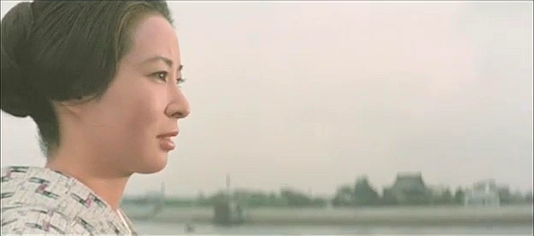
Headed by Beast Alley’s Junko Ikeuchi and filledout mainly by members of the Haiyuza theatre company, the cast give strongperformances all round and make the most of an intelligent script in which, refreshingly,scenes do not always play out in the way one might expect (e.g. theconfrontation scene between Chikako and a certain character’s wife). And whilethis may not be a film to wow you with its camerawork particularly, Gosho’sco-ordination of his actors is impressive and shows that he still had a sure hand.
*Gosho made an animated feature film using puppetsshortly after this one and later a half-hour documentary before passing away in1981.
